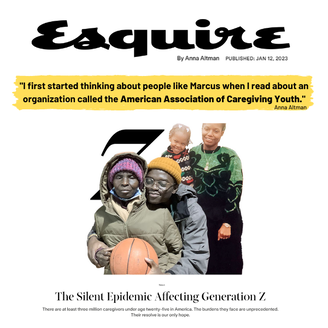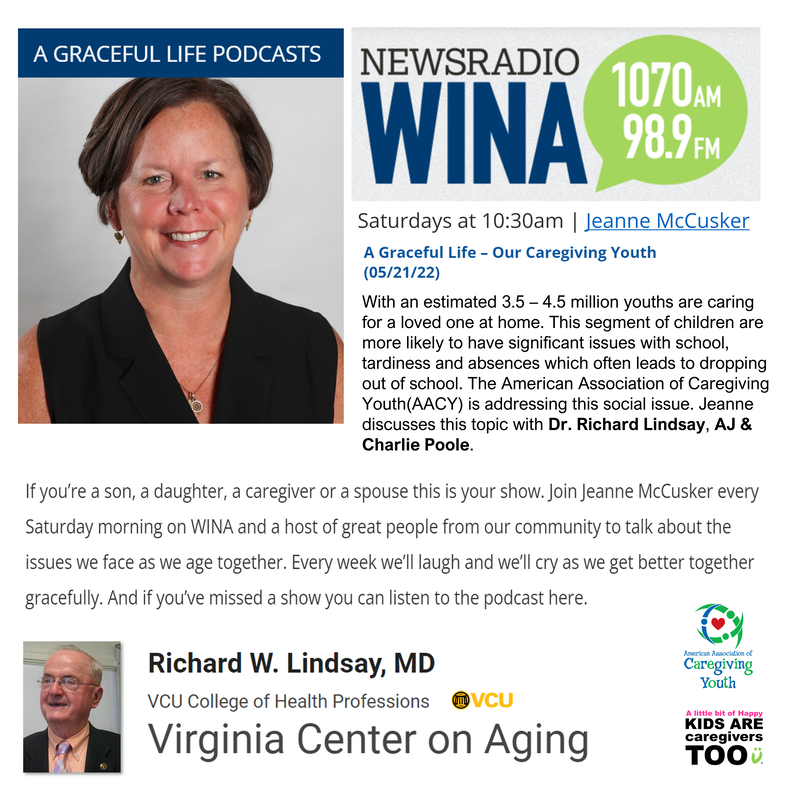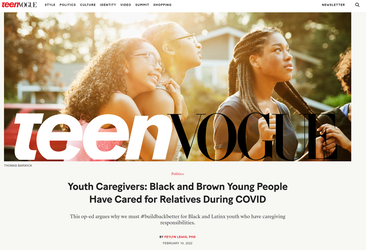Press & Articles
Thank you for attending this event on March 15, 2023
AACY Caregiving Youth Action Day USA 2023
AACY Caregiving Youth Action Day USA 2023
Boca Raton, FL. – Dr. Richard Lindsay, a member of the American Association of Caregiving Youth (AACY) National Advisory Council, his partner Dr. Rhonda Zingraff, Former Associate Dean at James Madison University, and Charlie Poole, a student at Christopher Newport University, former Caregiving Youth and advocate, will present at the Virginia Governor’s Conference on Aging on May 8, 2023, at 11 am. They will lead a breakout session called “At Risk: Caregiving Youth.”

The Silent Epidemic Affecting Generation Z
There are at least three million caregivers under age twenty-five in America. The burdens they face are unprecedented. Their resolve is our only hope.
By Anna Altman
PUBLISHED: JAN 12, 2023
This story was supported by the journalism nonprofit the Economic Hardship Reporting Project.
https://www.esquire.com/news-politics/a42287580/gen-z-caregivers/
November 18, 2022 | History was made today. Caregiving Youth were formally recognized for the first time ever in the United States.
Reps. Frankel, Barbara Lee, and Salazar Lead Resolution to Recognize and Support Caregiving Youth
Washington, DC – This week, Representatives Lois Frankel (D-FL-21), Barbara Lee (D-CA-13), and Maria Elvira Salazar (R-FL-27) introduced a resolution designating November 13-19, 2022, as National Caregiving Youth Week, and to recognize the efforts and sacrifices of youth under 18 caring for a loved one.
The resolution:
Supports the designation of National Caregiving Youth Week;
Recognizes caregiving youth in the United States as an underserved and underrecognized population;
Encourages educators, policymakers, health care professionals, and more to become more familiar with the work, needs, and contributions of caregiving youth; and
Supports Federal initiatives to provide up-to-date nationwide research on caregiving youth.
Full Resolution Here
Washington, DC – This week, Representatives Lois Frankel (D-FL-21), Barbara Lee (D-CA-13), and Maria Elvira Salazar (R-FL-27) introduced a resolution designating November 13-19, 2022, as National Caregiving Youth Week, and to recognize the efforts and sacrifices of youth under 18 caring for a loved one.
The resolution:
Supports the designation of National Caregiving Youth Week;
Recognizes caregiving youth in the United States as an underserved and underrecognized population;
Encourages educators, policymakers, health care professionals, and more to become more familiar with the work, needs, and contributions of caregiving youth; and
Supports Federal initiatives to provide up-to-date nationwide research on caregiving youth.
Full Resolution Here
Social Policy Report
The United States should recognize and support caregiving youth
Abstract
In the United States, more than 5.4 million children and adolescents under age 18 provide care for family members who are aging or have chronic illness, disability, or other health conditions that require assistance. In this policy report, we describe youth’s care for the family, and highlight the increasing prevalence, global challenges, and uneven successes of measurement and categorization. We briefly summarize research on how caregiving affects youth’s academic, social, and emotional well-being. Next, we present novel, emerging evidence from the public school-based 2019 Youth Risk Behavior Survey for the State of Florida, which suggests that as many as 24% of middle school students and 16% of high school students provide at least some care to the family on a regular basis. Drawing on this evidence, we discuss targeted social programs which have been shown to promote the well-being of caregiving youth outside of the United States, as well as a 13-year-old school-based intervention in The School District of Palm Beach County, Florida. We conclude with specific recommendations for a path toward recognizing and supporting caregiving youth via policy and practice in the United States. Our aim is to increase the awareness and feasibility of identifying and supporting caregiving youth and their families via government-organized data collection and targeted social policies. Full Report Here
In the United States, more than 5.4 million children and adolescents under age 18 provide care for family members who are aging or have chronic illness, disability, or other health conditions that require assistance. In this policy report, we describe youth’s care for the family, and highlight the increasing prevalence, global challenges, and uneven successes of measurement and categorization. We briefly summarize research on how caregiving affects youth’s academic, social, and emotional well-being. Next, we present novel, emerging evidence from the public school-based 2019 Youth Risk Behavior Survey for the State of Florida, which suggests that as many as 24% of middle school students and 16% of high school students provide at least some care to the family on a regular basis. Drawing on this evidence, we discuss targeted social programs which have been shown to promote the well-being of caregiving youth outside of the United States, as well as a 13-year-old school-based intervention in The School District of Palm Beach County, Florida. We conclude with specific recommendations for a path toward recognizing and supporting caregiving youth via policy and practice in the United States. Our aim is to increase the awareness and feasibility of identifying and supporting caregiving youth and their families via government-organized data collection and targeted social policies. Full Report Here
|
With an estimated 3.5 - 4.5 million youths are caring for a loved one at home. This segment of children are more likely to have significant issues with school, tardiness and absences which often leads to dropping out of school. The American Association of Caregiving Youth (AACY) is addressing this social issue. Jeanne McCusker discusses this topic with Dr. Richard Lindsay, AJ & Charlie Poole.
|
Daniela Castro-Martinez (R) with her mom, Sandra. Daniela became a youth caregiver after her mother’s ALS diagnosis.
McLean Brothers, High School Students Charlie, and A.J. Poole Raise Awareness for Caregiving Youth
The boys shared their story on caregiving for their grandmother through Alzheimer’s at the 6th Annual Brain Bowl event in Boca Raton, FL and are launching a local pilot program to help recognize caregiving youth
The boys shared their story on caregiving for their grandmother through Alzheimer’s at the 6th Annual Brain Bowl event in Boca Raton, FL and are launching a local pilot program to help recognize caregiving youth
Youth Caregivers: Before, During, and After the Pandemic
GENERATIONS JOURNAL - FALL 2021
|
This op-ed argues why we must #buildbackbetter for Black and Latinx youth who have caregiving responsibilities.
TeenVogue |
Youngsters without support can be at high risk for physical and mental problems in adulthood
marketwatch.com
marketwatch.com
New York Times
Lawmaker takes an interest in challenges facing youth caregivers
WPTV Channel 5 Palm Beach
Should Parents Add Kids to the Family Caregiving Team?
THE CAREGIVING RELATIONSHIP HAS RISKS AND BENEFITS FOR KIDS AND GRANDPARENTS. HERE'S HOW TO STRIKE A BALANCE.
U.S. News & World Report
Yes, 8-Year-Old Caregivers Exist
About 1.4 million children ages 8 to 18 are caregivers in the U.S.
U.S. News & World Report
STUDY: Medication administration by caregiving youth: An inside look at how adolescents manage medications for family members
| final_medication_article.pdf | |
| File Size: | 252 kb |
| File Type: | |
A Little Bit Of Happy/Kid Caretakers - Announce Brand Change to Include 'Kids Are Caregivers Too' - evolving Social Media Identity With More Descriptive Name
| press_release_a_little_bit_of_happy_name_change_9-21-18.pdf | |
| File Size: | 117 kb |
| File Type: | |
McLean Patch
Featured Press | We were honored to be on this list from our favorite Hometown Publication | Heroes And Givers: McLean People Worth Remembering In 2017 | 'Between first responders reuniting with a girl they saved and child caregivers, we look at the best people stories in McLean from 2017.' By Emily Leayman, Patch Staff
When Kids Are the Caregivers
Motivated by loyalty and love, kids take on oversized roles. Help is available.
U.S. News & World Report
The US needs to support and recognize youth caregivers
The Hill
Kids as Caregivers
Michigan State University
Spotlight on Longfellow MS Students Charlie and A.J. Poole and Their Campaign to Support Youth Caregivers
FCPS News Spotlight
The Hidden Population of Caregiving Youth in Our Schools
Psychology Benefits Society | APPLYING PSYCHOLOGICAL SCIENCE, BENEFITING SOCIETY
Young caregivers need support as numbers grow, University of Waterloo researcher says Young caregivers miss out on sports, school, social life and stress of role may make them sick too
CBC NEWS | Thunder Bay
McLean Boys Raise Awareness About Young Caregivers
By Emily Leayman Patch Publications
Children Who Give Care are Overlooked
Catholic Health Association of the United States
With love and fear, Alzheimer's youngest caregivers watch over parents
CNN
Children as Caregivers - by LeAne Austin, RN
Today's Caregiver
Forced To Grow Up Too Fast, Canada's Young Caregivers Face Trauma
HUFFPOST | By Craig and Marc Kielburger
Help for a 'hidden population' of caregiving kids
CNN
Shining the Spotlight on Kids Who Care
Brainline.org
Young Caregivers in the U.S | The Official Study Results 2005
The National Alliance for Caregiving
Helping Children Understand Alzheimer's Disease
National Institute on Aging
The Impact Caretaking Has On Children
UWM Today
ABC News Children Caregivers Face Difficult Challenges
ABC News
When Kids Are the Caregivers
U.S. News & World Report
A voice for America's caregiving kids
CNN
Supporting Children Who Serve as Caregivers
The New York Times
Invisible caregivers More than a million children and adolescents are caring for family members. What are the consequences for their development?
American Psychological Association
Kids and Caregiving: How Much Should They Really Do?
Parent Society
Kids As Caregivers Face Special Challenges
NPR
Caregiving Kids May Be at Risk
Psych Central
How Caring for Parents Affects Your Children
AARP
Shining a Light on Young Caregivers
Aging Today
Minnesota's invisible caregivers: A growing army of children take care of family members in need
Minnesota Star Tribune
Youthful Faces of Caregiving – Children Spend 2.5+ Hours a Day Helping
The Caregiver's Journal
Children here experience parental loss at higher rate than national average
Cincinnati Enquirer - Opioid Epidemic - "The epidemic's toll is hard to measure, but these numbers have to be considered every time you hear an ambulance passing or see one parked in the street," said Sharib. "Just about every time you see that, there are children involved.


